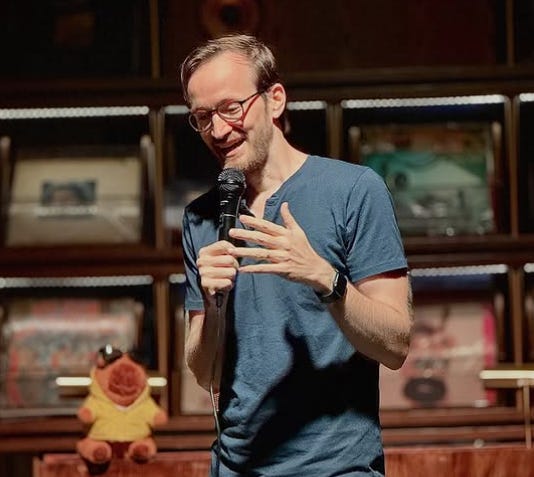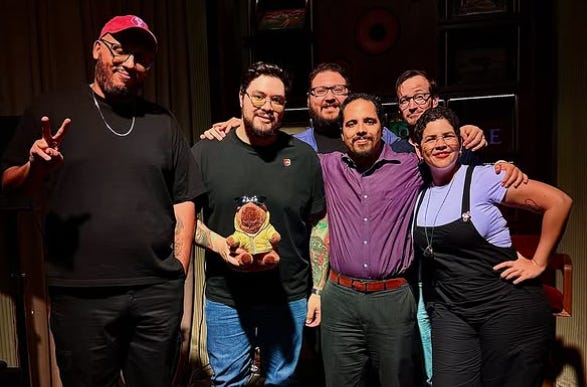The joke everyone laughed at except me
What a Spanish stand-up show taught me about inclusion.
Yesterday, I performed my second stand-up comedy set in Spanish y fue muy divertido.
I was definitely nervous considering my ability to speak Spanish was surpassed by my 4 year old daughter… 2 years ago. But the set went well and I walked off stage thinking, “Okay, estoy mejorando.”
But my biggest “aha” came when I sat back down and watched the rest of the performers.
The audience would erupt into huge, rolling laughter at jokes I only half understood. I would smile, nod, and laugh politely a second or two behind everyone else.
It felt like trying to enter a conversation a beat too late. Not excluded intentionally, but still very aware that I was not fully in the in-group.
There was one joke in particular where a comedian said something, there was a brief pause, and then a huge laugh and extended applause break. And I was just sitting there thinking, “que?”
(I wish I could tell you what the joke was, but honestly, I have zero idea of what the comedian was even talking about.)
In that moment, I was fully reminded that humor is one of the fastest ways humans create belonging. If you get the joke, you feel like one of the group. You’re fast friends, on the same side, and having fun together.
But if you don’t get the joke, you feel like an outsider, even if only for a second. And that feeling, in a comedy club or a conference room, matters more than we often realize.
Why Using Humor with Intention Matters
I talk a lot about humor as a skill, and this experience reinforced why that matters.
When people don’t use humor intentionally, when they just “wing it,” they tend to fall back on what worked in familiar environments: the sarcasm they used in high school, the banter their college friends loved, the puns they see in real life that they share with their BFF (is that just me?).
That works great with the people who share the same history. It works less well when the room is mixed. Add different ages, backgrounds, cultures, power dynamics, or even language levels, and suddenly the “funny” falls flat.
Some people react by avoiding humor altogether because they don’t want to get it wrong. Others keep using humor freely without thinking about the ripple effect.
Intentional humor sits in the middle. It’s thoughtful, flexible, and adaptive. And most importantly, it’s inclusive.
Three Steps to More Inclusive Humor
Creating the type of humor that brings people in versus pushes people away requires Consideration (one of the eight competencies of humor).
If you want to be the type of leader (or person) that uses humor to build relationships and community, here are three things to keep in mind:
1. Know Your Audience, Including the Quiet Ones
Context shapes comedy. Before using a joke that works with your best friends, take a moment to consider who is actually in the room. What do they need? What do they expect? What’s your relationship with them? Who might be smiling politely even if they do not fully get it?
Humor lands best when you understand the real humans hearing it.
2. Avoid Punching Down
If someone has to pay for the laugh, let it be you. Self-deprecating humor, observational humor, or story-based humor usually land safely. Making someone else the target is far riskier. If the joke sacrifices someone’s confidence or comfort, the long-term cost outweighs the short-term laugh.
And don’t forget a cardinal rule of playful teasing: never make fun of someone for something they can’t change.
3. Use Humor as a Bridge, Not a Shortcut
Inside jokes are powerful bonding tools, but only if everyone is inside. If your humor references something only a few people understand, add quick context or choose a more universal angle.
Inclusive humor brings people along for the ride rather than assuming they are already strapped in.
Humor is a Bridge to Connection
Humor isn’t just about laughter. It’s about belonging, connection, and shared understanding. It’s about whether we feel like we are part of something or standing slightly outside of it.
And that awareness matters everywhere we go, from a comedy club in Panama City to the conference room on a Tuesday morning.
Because despite only catching fifty percent of the jokes last night, I still felt welcomed. The comedians, the producers, and the audience made space for me even though mi espanol no es bueno.
Now I just need to improve my Spanish before the next show... maybe my 4 year old can help.
Con Humor,
-Andrew






Thank you for putting this in context. I’ve been hearing and telling medical jokes for 43 years. Those of us who understand the inside joke get a laugh and connection. Those who don’t understand are left out. When in a group or the rare open mic, I tend to tell the diarrhea and constipation and Viagra jokes that most people would understand. I started a website, humorclinic.com. If you have to explain a joke, it’s not funny. We plan to have a tab on every joke for explanation, so no one will be excluded.